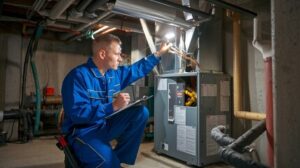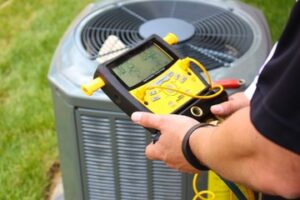A heat furnace is a fundamental component of residential and commercial heating systems, playing a crucial role in maintaining comfortable indoor environments during cold weather. Its primary function is to generate and distribute heat throughout a building, ensuring that occupants experience consistent warmth even when outdoor temperatures drop to uncomfortable levels.

Over the years, the design and efficiency of heat furnaces have undergone significant improvements, driven by technological advancements and a growing focus on energy conservation. Understanding the principles behind how a heat furnace works, the different types available, and the importance of maintenance can help individuals and building managers make informed decisions about heating systems and improve overall comfort and energy efficiency. Contact Mr. Heat Furnace Orillia for professional help.
At its core, a heat furnace operates by converting energy from a fuel source or electricity into heat, which is then circulated through the building’s ventilation system. The process begins when the thermostat detects that the indoor temperature has fallen below the set level. This triggers the furnace to activate, initiating the heating cycle. In gas or oil-fired furnaces, the fuel is ignited in a combustion chamber, producing heat. The heat is transferred to a heat exchanger, where it warms the air or water that will be distributed through the building. A blower or pump then pushes the heated air or water through a network of ducts or pipes, ensuring that warmth reaches all parts of the building. In electric furnaces, heating elements are used to generate heat directly through electrical resistance. Once the desired temperature is achieved, the thermostat signals the furnace to shut off until additional heating is required. This cycle repeats automatically, maintaining a consistent and comfortable indoor climate.
The efficiency of a heat furnace is measured by its annual fuel utilization efficiency (AFUE) rating, which indicates the percentage of energy converted into usable heat. A higher AFUE rating means that more of the energy consumed by the furnace is converted into heat, reducing energy waste and lowering operating costs. Modern furnaces are designed to achieve AFUE ratings of 90% or higher, meaning that only a small fraction of the energy used is lost through exhaust gases or heat loss. High-efficiency furnaces achieve this performance by using advanced components such as secondary heat exchangers, sealed combustion chambers, and variable-speed blowers. Secondary heat exchangers capture additional heat from exhaust gases before they are vented outside, increasing the overall efficiency of the system. Sealed combustion chambers prevent heat loss and improve safety by ensuring that combustion gases do not leak into the indoor environment. Variable-speed blowers adjust airflow based on heating demand, reducing energy consumption and providing more consistent heating.
There are several types of heat furnaces available, each with unique characteristics and advantages. Gas furnaces are among the most common, using natural gas or propane as a fuel source. They are known for their quick heating capabilities and relatively low operating costs, making them a popular choice for both residential and commercial buildings. Oil furnaces are another option, particularly in areas where natural gas infrastructure is limited. Oil furnaces produce a high level of heat output and are well-suited for colder climates, but they require regular fuel deliveries and maintenance to ensure proper operation. Electric furnaces use electric resistance coils to generate heat, making them highly efficient and easy to install. However, their operating costs can be higher due to the price of electricity. Heat pumps are becoming an increasingly popular alternative to traditional furnaces. They work by extracting heat from the air or ground and transferring it into the building. While heat pumps are highly efficient and provide both heating and cooling functions, their performance can be affected by extremely cold temperatures, which may require the use of a backup heating source.
Proper installation is critical to the performance and efficiency of a heat furnace. A furnace that is too large or too small for the building’s heating load can result in uneven heating, increased energy consumption, and premature wear on components. Professional installation by a qualified technician ensures that the furnace is correctly sized, that all components are properly connected, and that safety measures are in place. During installation, the technician will assess factors such as building size, insulation levels, and ventilation design to determine the appropriate furnace capacity. Correct installation of ductwork is also essential to ensure that heated air is distributed evenly throughout the building. Leaky or poorly designed ducts can lead to heat loss and reduced efficiency, forcing the furnace to work harder to maintain the desired temperature.
Regular maintenance is necessary to keep a heat furnace operating at peak efficiency and to prevent costly breakdowns. Maintenance tasks include inspecting and cleaning the heat exchanger, checking the ignition system and burners, lubricating moving parts, and replacing air filters. Dirty or clogged air filters can restrict airflow, causing the furnace to work harder and increasing energy consumption. Replacing filters regularly improves airflow, enhances heating performance, and extends the lifespan of the furnace. The heat exchanger should be inspected for cracks or signs of wear, as damaged heat exchangers can lead to dangerous carbon monoxide leaks. The ignition system and burners should be cleaned and adjusted to ensure consistent and reliable combustion. Lubricating moving parts such as the blower motor and fan reduces friction and prevents mechanical failures.
The quality of indoor air is directly influenced by the performance of a heat furnace. Furnaces with high-quality air filters and ventilation systems can remove dust, allergens, and pollutants from the air, improving indoor air quality and creating a healthier environment for occupants. High-efficiency particulate air (HEPA) filters capture small particles, including pollen, pet dander, and mold spores, reducing respiratory issues and allergic reactions. Some furnaces are equipped with UV light purifiers or electrostatic filters that eliminate bacteria, viruses, and mold spores, further enhancing air quality. Maintaining proper humidity levels is also important for comfort and health. Dry indoor air can cause dry skin, respiratory issues, and static electricity, while excessive humidity can promote mold growth and create an uncomfortable environment. Furnaces with integrated humidifiers and dehumidifiers allow users to control humidity levels, improving overall comfort and air quality.
Zoning systems are an effective way to improve the efficiency and comfort of a heat furnace. Traditional furnaces use a single thermostat to regulate the temperature of an entire building, which can lead to uneven heating and energy waste. Zoning systems divide a building into separate zones, each with its own thermostat and control settings. This allows users to customize the temperature in different areas based on occupancy and preference, ensuring that heat is delivered where it is needed most. Zoning systems use dampers in the ductwork to direct airflow to specific areas, reducing energy waste and improving comfort. For example, a zoning system can maintain a higher temperature in the living room during the day while keeping bedrooms cooler at night, resulting in more efficient energy use and lower heating costs.
Technological advancements have led to the development of smart thermostats and building automation systems that enhance the performance and convenience of heat furnaces. Smart thermostats allow users to program heating schedules, adjust settings remotely, and receive real-time updates about system performance. Some smart thermostats use learning algorithms to analyze usage patterns and make automatic adjustments to improve efficiency and comfort. Building automation systems integrate heating controls with other building systems, such as lighting and security, to create a responsive and energy-efficient environment. Sensors and data analysis enable the system to make real-time adjustments based on occupancy, outdoor weather conditions, and user preferences, optimizing furnace performance and reducing energy consumption.
The future of heat furnace technology is focused on improving energy efficiency, reducing environmental impact, and increasing user convenience. Innovations such as condensing furnaces, which use a secondary heat exchanger to capture and reuse heat from exhaust gases, are helping to achieve higher AFUE ratings and reduce energy waste. Renewable energy sources, such as solar and geothermal, are also being integrated into furnace systems to reduce reliance on fossil fuels and lower carbon emissions. Hybrid systems that combine heat pumps with traditional furnaces offer the flexibility to switch between heating sources based on outdoor temperatures and energy costs, maximizing efficiency and comfort. Research and development in materials science and engineering are leading to the creation of more durable and lightweight components that improve furnace performance and reduce maintenance requirements.
A well-maintained and properly installed heat furnace is essential for creating a comfortable and energy-efficient indoor environment. Understanding the different types of furnaces, their operating principles, and the factors that influence their performance allows homeowners and building managers to make informed decisions about heating systems. Regular maintenance, high-quality air filters, zoning systems, and smart controls can further enhance furnace performance and reduce energy costs. As technology continues to evolve, heat furnaces will become even more efficient and environmentally friendly, providing reliable and cost-effective heating solutions for modern living.
4o
